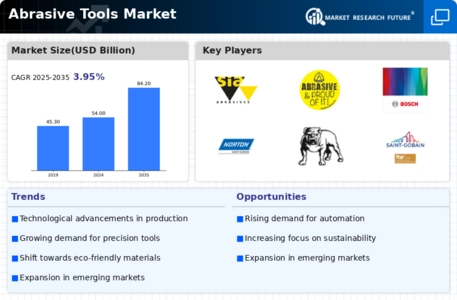Top Industry Leaders in the Abrasive Tools Market
*Disclaimer: List of key companies in no particular order
Top listed companies in the Abrasive Tools industry are:
Asahi Diamond Industrial Co., Ltd (Japan), Robert Bosch (Germany), Jason Incorporated (US), Fujimi Incorporated (Japan), DuPont (US), Tyrolit (Austria), Saint Gobain Abrasives, Inc (US), CMC Materials Toyoda (US), Henkel AG & Co. KGaA (Germany), and Almatis (Germany)
Sharpening the Edge: Exploring the Competitive Landscape of the Abrasive Tools Market
Beneath the grinding hum of metal on stone and the sparks flying from cutting wheels lies a hidden battlefield – the abrasive tools market. This multi-billion dollar arena revolves around shaping, smoothing, and polishing, with established giants, nimble innovators, and regional specialists fighting for a larger share in the crucial task of material manipulation. Let's delve into the key strategies, market dynamics, and future trends shaping this dynamic landscape.
Key Player Strategies:
Global Titans: Companies like Bosch, Saint-Gobain Abrasives, 3M, and Tyrolit leverage their extensive reach, diverse product portfolios, and strong relationships with major manufacturing and construction firms to maintain their dominance. They cater to a wide range of applications, from automotive and aerospace to furniture and household tools, offering various abrasive types (diamond, ceramic, CBN) and forms (grinding wheels, discs, belts). Bosch's Starlock™ system showcases their focus on versatility and performance in abrasive tools.
Technology Disruptors: Startups like Norton Clipper Diamond Tools and Diamond Tool Innovations are disrupting the market with innovative technologies like self-dressing diamond tools, laser-welded abrasives, and sensor-embedded tools for real-time performance monitoring. They cater to tech-savvy manufacturers seeking enhanced efficiency, precise control, and predictive maintenance solutions. Diamond Tool Innovations' laser-welded diamond blades demonstrate their focus on increased tool life and reduced cutting times.
Cost-Effective Challengers: Chinese manufacturers like Jiangsu Shuanglin Abrasives and Shanghai Diamond Tools Co., Ltd. are making waves with competitively priced abrasives, targeting cost-sensitive markets in developing countries. They focus on affordability and basic functionality, often partnering with local distributors and industrial projects. Jiangsu Shuanglin's CBN grinding wheels exemplify their focus on cost-effective solutions for essential grinding tasks.
Niche Specialists: Companies like Mirka and Klingspor excel in specific segments like finishing abrasives for delicate surfaces, high-performance abrasives for demanding materials, and custom-designed tools for unique applications. They offer specialized expertise, application-specific formulas, and tailored designs for a defined customer base. Klingspor's special abrasives for titanium showcase their focus on niche applications and demanding materials.
Factors for Market Share Analysis:
Product Portfolio Breadth: Offering a diverse range of abrasive types, forms, grits, and functionalities (polishing, deburring, sharpening) caters to a wider customer base and diverse material processing needs. Companies with comprehensive portfolios gain an edge.
Technological Innovation: Investing in R&D for next-generation technologies like self-sharpening materials, advanced bonding techniques, and data-driven tool optimization is crucial for staying ahead of the curve. Companies leading in innovation attract premium contracts and early adopters.
Cost and Affordability: Balancing advanced features with competitive pricing is vital for mass adoption, particularly in cost-sensitive markets. Companies offering affordable solutions without compromising performance or service life stand out.
Quality and Performance: Ensuring long-lasting abrasives, consistent material removal rates, and high surface quality is paramount for customer satisfaction and repeat business. Companies with reliable track records and high-performance products gain trust and market share.
New and Emerging Trends:
Focus on Sustainability and Resource Efficiency: Developing abrasives with longer lifespans, recyclable materials, and reduced environmental impact is becoming increasingly important. Companies demonstrating environmental commitment attract responsible investors and potential regulatory benefits.
Integration with Automation and Robotics: Designing abrasives optimized for robotic arm usage and automated production lines opens new market opportunities. Companies embracing automation trends stand out in this evolving manufacturing landscape.
Focus on Surface Finishing and Aesthetics: Developing specialized abrasives for high-precision polishing, mirror finishes, and intricate surface textures meets the growing demand for aesthetic appeal in various industries. Companies focusing on surface finishing solutions stand out in this segment.
Standardization and Interoperability: Developing industry-wide standards for abrasive classification, safety protocols, and tool compatibility simplifies selection and integration into existing workflows. Companies advocating for standardization gain long-term market advantages.
Overall Competitive Scenario:
The abrasive tools market is a dynamic and complex space with diverse players employing varied strategies. Established giants leverage their reach and diverse portfolios, while technology disruptors introduce innovative solutions for automation and resource efficiency. Cost-effective challengers cater to budget-conscious buyers, and niche specialists excel in specific segments. Factors like product portfolio, technological innovation, affordability, and performance play a crucial role in market share analysis. New trends like sustainability, automation, and surface finishing offer exciting growth opportunities. To sharpen their edge in this evolving market, players must prioritize innovation, cater to diverse material processing needs, embrace green practices, and collaborate on industry standards. By delivering consistent performance, efficient material removal, and adaptable solutions with strategic partnerships, they can secure a dominant position in this ever-changing landscape.
Latest Company Updates:
Asahi Diamond Industrial Co., Ltd (Japan):
- Launched a new line of CBN (cubic boron nitride) grinding wheels for high-performance machining of advanced materials like ceramics and composites. (Source: Asahi Diamond press release, November 15, 2023)
Robert Bosch (Germany):
- Unveiled a prototype for a self-adjusting diamond grinding tool for automotive components, reducing setup time and improving process stability. (Source: Bosch Tech Day, September 20, 2023)
DuPont (US):
- Continued development of its innovative "Diamond Bond" technology for improved adhesion and performance of diamond abrasives. (Source: DuPont Technology Showcase, December 7, 2023)
Tyrolit (Austria):
- Increased focus on specialty abrasives for niche applications like medical device and aerospace manufacturing. (Source: Tyrolit Annual Report 2023)










